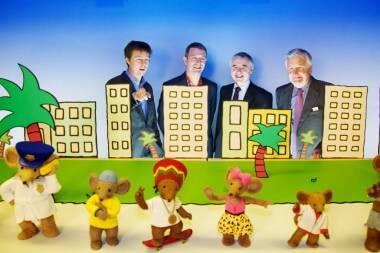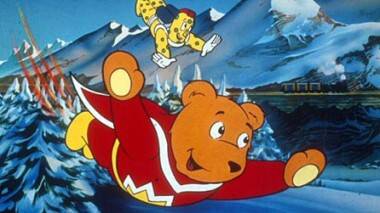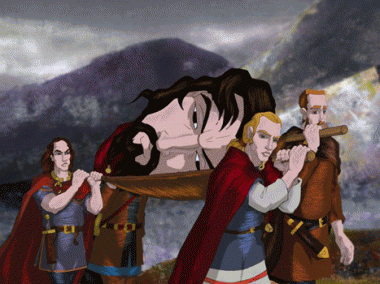The Current State of Animation in Wales: Part One
Just before we begin I thought I’d add a little disclaimer. This article isn’t a “History of Welsh Animation”. This is a personal observation about the current state of Welsh animation, but to look at the present we will quickly have to take some advice from Kylie Minogue and “step back in time.”
The Golden-Age of Welsh Animation
It’s the early 90s and Wales is experiencing a Golden age of Animation production. The Welsh language channel S4C has been integral in helping to produce a number of popular animated shows; Superted, The Shoe People (Siriol Productions), Fireman Sam (Bumper Films), and Gogs (Aarrggh! Productions) are just some of the many Welsh produced; high-profile shows commissioned over the previous decade. S4C has rapidly gained a reputation, nationally and internationally for their commercially successful and award-winning animation programme, developed under the watchful eye of Commissioning Editor Chris Grace. As S4C expanded, a host of popular characters followed in SuperTed’s footsteps. Produced at Siriol were; Wil Cwac Cwac and Toucan Tecs, while Funnybones was being produced at Cartwn Cymru.
Over the years, S4C started to take some calculated risks with the type of animation they commissioned as Grace’s vision for a mixture of “commercially creative” output took shape. They made longer cartoons, animations based on famous Operas, Chaucer’s’ “Canterbury Tales” and stories from the Bible. Many of these were often co-productions made in Wales and Eastern Europe and Russia. Shakespeare: The Animated Tales, a series of twelve, half-hour, animated television episodes, was broadcast on BBC 2 between 1992 and 1994. Commissioned for S4C by BBC Wales, production was co-ordinated in Wales by Dave Edwards Animation Studio (Dave was the Director of the SuperTed cartoons) while the animation was produced in Russia.
These studios having now successfully cut their teeth on short-form series production made tentative steps into feature production, Siriol with Under Milk Wood an adaptation of the Dylan Thomas radio-play and The Princess and The Goblin a co-production with a Hungarian animation studio. In 2003 Cartwn Cymru released their version of Y Mabinogi to mixed critical and commercial acclaim.
S4C also gained a reputation for supporting independent animation talent. Films made for the channel by artists such as Joanna Quinn, Gerald Conn, Clive Walley, Jane Hubbard and Phill Mulloy gained notoriety, won a variety of awards from BAFTA to Oscar nominations and became regular features in film festivals around the world, all helping advance the reputation of Welsh animation around the world.
The budget that S4C could ring-fence for animation gradually grew smaller and smaller. This coupled with the departure of Chris Grace from the company eventually sounded the death-knell for the industry in Wales as it was. Production houses had to quickly seek out new funding partners, often resulting in productions being financed by multiple partners internationally and the communication problems that can arise from this method of working are still prevalent today.
The majority of the studios around during that Golden age are now gone; Cartwn Cymru are gone, as are Bumper Films. Siriol, now re-named Calon, operate at a drastically reduced size and Aargh Productions closed their doors over a decade ago. Obviously, just because a studio has closed doesn’t mean that the talent has suddenly disappeared. One of the guys behind Aargh! for instance; Mike Mort, runs a very successful stop-motion studio, Immortal Pictures. Oscar nominated animation director, Joanna Quinn, runs a successful commercial animation studio, Beryl Productions, with her partner Les Mills. The most recent casualty was a South Wales studio called Dinamo Productions and for myself and a lot of my Welsh animation friends and colleagues it’s been the most personal.
DINAMO
You may, or may not, be familiar with Dinamo Productions. If you have young children and watch a lot of Cbeebies (as I do), chances are you‘ll be very familiar with this BAFTA award winning animation studio. Rastamouse, Grandpa in my Pocket, Iconicles, Fun with Claude, Abadas, Soli & Mo’s Nature Show and The Lingo Show were all Dinamo Productions.
Setup by Welsh Animators Owen Stickler and Aron Evans in 2004, Dinamo started small, working on VFX and title-sequences for shows on Welsh broadcast channel S4C. One of their first employees was a young Director and VFX artist named Jon Rennie;
“Dinamo was my first introduction to the animation industry” says Jon, currently Managing Director of Bait Studio and Cloth Cat Animations. “I started there in late 2004, working on the satirical Welsh series CNEX, using After Effects to add production value to the animation set pieces. It was an exciting time to be involved and we were a small team of about seven people, all crammed in rooms at Chapter Arts Centre in Cardiff. From there, we grew rapidly [moving to lease office-space in Calons’ building in Mount Stuart Square in Cardiff Bay] and I became Head of Visual Effects. After about five years at Dinamo, I wanted the opportunity to grow my career and return to filmmaking, leaving to setup my own VFX Company in early 2010.”
Around the same period, Dinamo started work on two of their largest productions to date, both to be partly financed and broadcast by the Cbeebies channel. Iconicles, a joint production with Cbeebies and Create Media, 26 x 25 minute episodes that combined 2D Cel-Action animation sequences and CG animation integration with a live-action presenter and Rastamouse, 52 x 10 minutes of stop-motion for Cbeebies, Three Stones Media and The Rastamouse Company. Both were massive productions that required large crews.
In June 2010, with financial help from the Welsh Government, Dinamo took a 5 year lease on the Rizla Factory in Trefforest [the irony of Rastamouse being made in an ex-Rizla factory wasn’t lost on anybody] and started hiring for their new productions. They had a number of high-profile shows in various stages of production including Series 3 of Grandpa in my Pocket for Adastra Creative and Cbeebies and Fun with Claude for Playhouse Disney. The official opening of the studio received a lot of press and broadcast coverage and Dinamo became the largest producer of broadcast animation in Wales. Gemma Martin was a 2D Animator who started with Dinamo in 2008;
“After 3 years of short term contracts and freelance work, it was exciting to be involved in such an ambitious and thriving company, and on a long term project, animating on the children’s series ‘Fun with Claude’. With [multiple] projects in production, Dinamo rapidly expanded in size. It was a bustling place, filled with very talented and hard-working people.”

Aron Evans (Far left)and Owen Stickler (middle-left) with Ieuan Wyn Jones AM and Minister for Heritage, Alun Ffred Jones AM
They hired the majority of the stop-motion crew that had recently finished Igam Ogam for Calon to work on Rastamouse. The bulk of the recently graduating traditional animation and CG animation courses at the nearby University of Glamorgan were hired on project contracts to work on Iconicles, an experienced digital compositing and VFX team were already in place and the core staff moved into team-leadership and project co-ordination roles. Some of us were lured from their long-term jobs by the excitement of working on a challenging and high-profile new project that was seemingly going to reawaken the slumbering Welsh Animation Dragon. Like the freshly-painted green, orange and yellow walls in the animation studio, the future for Dinamo Productions seemed bright.
In Part Two we’ll take a look at where things started to go wrong for Dinamo as well as what the future holds for the Welsh animation industry.



